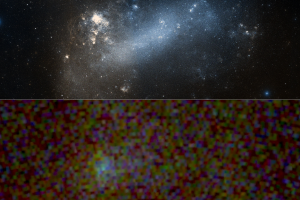γ-ray emission from the supernova remnants in the Large Magellanic Cloud. The paper: “High-energy γ-ray detection of supernova remnants in the Large Magellanic Cloud” of R. Campana (INAF – OAS) recently appeared on MNRAS

Supernova remnants are expanding nebulae produced by the explosion of high-mass stars. They are of great interest for understanding various physical processes and the final evolutionary stages of massive stars. Observations of supernova remnants in gamma rays are particularly important as they shed light on high-energy processes, such as the acceleration of cosmic rays (charged particles at very high energies).
The Large Magellanic Cloud is one of the best astrophysical objects to observe supernova remnants. This satellite galaxy of the Milky Way is, in fact, rich in remnants, compact objects, and very massive star-forming regions, where rich populations of massive stars, known as “OB associations“, form. Due to these unique properties, the Large Magellanic Cloud has been observed in gamma-rays by several observatories.
The team, led by the astronomer R. Campana from INAF – Astrophysical Observatory and Space Science Center of Bologna, has analyzed the complete set of gamma-ray observations of the Large Magellanic Cloud collected in 12 years by the NASA satellite Fermi Gamma-Ray Space Telescope. Their goal was to study the spatial correlation between the locations in the sky of the most energetic events collected by Fermi with those of the known supernova remnants in the galaxy. To achieve this, the team adopted two methods for analyzing the spatial distribution and clustering, e.g. the identification of statistically significant regions where the events are grouped together, namely the statistical method called “Minimum Spanning Tree” and the unsupervised machine learning method called “DBSCAN”. This analysis allowed the identification of 20 clusters of gamma-ray events, among which 7 correspond to the known locations of supernova remnants. The age of these remnants varies from 1140 years (B0540-693) to 10,000 years (N49B). Two are also associated with known compact objects: a pulsar in N157B (5000 years), which is part of the OB association LH99, and a magnetar in N49A (4800 years). Additionally, the supernova remnant N63A (3500 years), associated with the star forming region N63, is likely associated with a “pulsar wind nebula”, which is a compact cloud of charged particles associated with a neutron star. Finally, a cluster is associated with the remnant N132D, which is the brightest in X-rays among this sample. However, it is not clear whether the cluster named N44 is associated with the supernova remnants that populate a rich star-forming region containing 3 OB associations. The study is described in the paper: “High-energy γ-ray detection of supernova remnants in the Large Magellanic Cloud”, recently appeared on The Monthly Notices of the Astronomical Royal Society. Among the coauthors are F. Bocchino and S. Orlando of INAF – Astronomical Observatory of Palermo and M. Miceli of the University of Palermo, associated to INAF.
The image (click here to visualize the entire image) shows the Large Magellanic Cloud observed in optical band with SDSS (upper panel) and in gamma-rays with Fermi (bottom panel).
Mario Giuseppe Guarcello ( follow mariospiegacose) ( mariospiegacose) ( follow mariospiegacose)
Follow the Astronomical Observatory of Palermo on Facebok
Subscribe the Youtube channel of the Astronomical Observatory of Palermo
